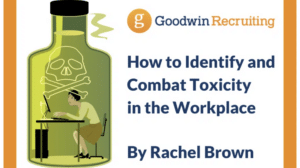How to Identify and Combat Toxicity in the Workplace
Rachel Brown, DBA, MAED | Leadership, Opportunity for All | July 14, 2022

Every organization operates as an individual live entity. Each embodies a personality that is reflective of the leadership, environment, and its members. This persona is defined as the organization’s work culture, which can be positive (healthy and nurturing) or negative (unhealthy and toxic), or somewhere in between.
It is important for a company to sustain and build on positive traits while addressing, minimizing, and eliminating negative ones. This has become increasingly important in our post-pandemic world, in which lack of inclusion, fairness, and purpose at work continue to drive the Great Resignation.
How do companies identify toxicity in the workplace? How is assessing and improving company culture accomplished?
Methods companies use to take an internal temperature
To determine whether a work environment is healthy or unhealthy, companies employ various types of surveys to measure job satisfaction, job engagement, and other metrics. Periodically performed, this is a great way to gauge and monitor internal climate temperature. Along with measuring employee retention and job performance, an organization can evaluate on a matrix scale what they are doing right and whether there might be red flags and concerns causing disruptions.
Although these matrices can be good indicators, there are characteristic traits and behaviors every organization needs to be able to identify – again, both positive and negative.
- Identifying toxicity in the workplace is critical because it increases an organization’s ability to combat a problem at its root. Not every identification leads to the termination of a problem or person. For example, there are times when a newly appointed leader struggles with the Peter Principle and needs executive coaching and training. Or maybe this individual would be more successful in working with a different team. On the other hand, there are bad bosses out there who are contributors to toxic work environments, and no amount of coaching or training will help. Each problem identified needs thoughtful and thorough consideration. The key is to identify and deal with it.
- Identifying positive characteristics and behaviors is just as critical so that they can be rewarded, proliferated, and emulated. There is a world of truth in the expression, “What gets recognized gets repeated.” Seeing people and teams get recognized can have a positive impact on great employees, as well as those who exhibit unhealthy behavior. The result is a healthier, more productive workplace.
Toxic workers are not necessarily low performers
The opposite is usually true. Most toxic employees are the ‘rock stars’ of a company, and negativity from one individual can pull down 80% of an organization’s performance (Anjum & Ming, 2018). Why and how? Employees do not always come forward and communicate when there is a problem. They may instead exhibit a decrease in attendance, lower performance, health problems, depression, and employee turnover. These effects can be costly to any organization and have a long-term impact on employees’ self-esteem and mental health. Is every rock star worth this cost?
There is a link between job stress and harmful behavior
Toxicity can organically develop and cause dysfunction if given the right internal climate. Poor leadership, job stress, workplace silos, favoritism, ostracism, narcissism, bullying, incivility, passivity, low morale, burnout, high turnover rates, cliques, lack of communication – any combination of these stressors can contribute to a hostile work environment.
A healthy environment is a place of cohesive collaboration among team members that produces harmony and productivity and uses problems to facilitate positive change. A toxic workplace is harmful to teams, groups, and individuals.
How prevalent is toxicity, and how can it be eradicated?
According to research, three out of 10 leaders manifest toxic behaviors. To guarantee that your organization maintains a healthy, productive environment, make certain that leadership fits the organization’s vision, mission, and core values and motivates the team’s productivity and well-being. Employee performance is influenced and motivated by the leadership of the organization. (Paltu & Brouwers, 2020; Veldman & Veldman, 2017)
Take an active role in keeping your culture healthy
As with any illness, the likelihood of a positive outcome increases when unhealthy workplace characteristics are treated in the preliminary stages. I highly recommend Dr. Roy H. Lubit’s book, “Coping with Toxic Managers, Subordinates…and Other Difficult People: Using Emotional Intelligence to Survive and Prosper.” It is an excellent resource on how organizations and managers can improve work culture by increasing the emotional intelligence of a company.
Human capital is your company’s greatest asset
If you are motivated to drive higher employee satisfaction and more robust company performance, use your human resources team or a consultant to help you assess and maintain a positive working environment. Keep it healthy!
Share This Article







































